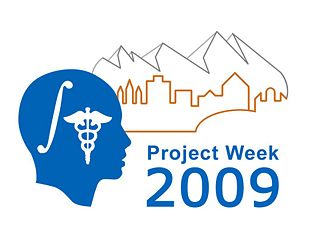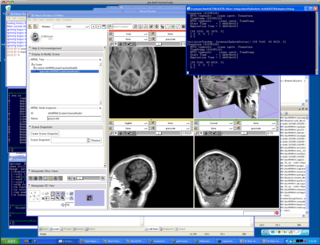Difference between revisions of "2008 Winter Project Week:IGT IGSTK Slicer"
m (Text replacement - "http://www.slicer.org/slicerWiki/index.php/" to "https://www.slicer.org/wiki/") |
|||
| (19 intermediate revisions by 4 users not shown) | |||
| Line 1: | Line 1: | ||
{| | {| | ||
|[[Image:NAMIC-SLC.jpg|thumb|320px|Return to [[2008_Winter_Project_Week]] ]] | |[[Image:NAMIC-SLC.jpg|thumb|320px|Return to [[2008_Winter_Project_Week]] ]] | ||
| − | |valign="top"|[[Image: | + | |valign="top"|[[Image:Slicer-igstk.png |thumb|320px|IGSTK Slicer]] |
|} | |} | ||
| Line 13: | Line 13: | ||
<h1>Objective</h1> | <h1>Objective</h1> | ||
| − | + | IGSTK provides connectivity with various kinds of tracking devices. | |
| + | However, IGSTK does not support communication with tracking devices over the network. | ||
| + | The objective of this project is to establish Slicer-IGSTK connection through standard network to provides extensible and versatile way of configuration in image guided therapy. | ||
| + | |||
</div> | </div> | ||
| Line 19: | Line 22: | ||
<h1>Approach, Plan </h1> | <h1>Approach, Plan </h1> | ||
| − | + | We will design and implement a module to communicate with 3D slicer as a class of IGSTK. It connects to [[Tracker_Daemon]] through TCP/IP and controls MRML scene (tracker and real-time image). | |
</div> | </div> | ||
| Line 25: | Line 28: | ||
<h1>Progress</h1> | <h1>Progress</h1> | ||
| + | ====Jan 2008 Project Half Week==== | ||
| + | We completed following tasks: | ||
| + | *The bi-directional socket communication has been established between the Tracker Daemon in Slicer 3 and IGSTK Server which acquires tracking data from device and sends it to Tracker Daemon. | ||
| + | *Real-time image transfer function is implemented using Slicer Daemon mechanism. | ||
| + | *[[OpenIGTLink]] Protocol has been designed, and partially implemented in OpenIGTLinkDaemon Module in Slicer 3. | ||
====June 2007 Project Week==== | ====June 2007 Project Week==== | ||
| Line 30: | Line 38: | ||
====Jan 2007 Project Half Week==== | ====Jan 2007 Project Half Week==== | ||
| − | + | Noby and Haiying developed the vtkIGTOpenTrackerStream class, which gives connectivity with NaviTrack data stream to the Slicer. This class shares a base class with vtkIGTIGSTKStream. | |
| − | |||
</div> | </div> | ||
| Line 39: | Line 46: | ||
</div> | </div> | ||
| + | ===References=== | ||
| − | === | + | ===Links=== |
| + | *[[NA-MIC_NCBC_Collaboration:An_Integrated_System_for_Image-Guided_Radiofrequency_Ablation_of_Liver_Tumors |NCBC Collaboration Project: An Integrated System for Image Guided Raduifrequency Abation of Liver Tumors]] | ||
| + | *[https://www.slicer.org/wiki/Slicer3:ProstateModule 3D Slicer Prostate Module for Transperineal Needle Biopsy Robot] | ||
Latest revision as of 17:27, 10 July 2017
Home < 2008 Winter Project Week:IGT IGSTK Slicer Return to 2008_Winter_Project_Week |
Key Investigators
- BWH: Nobuhiko Hata, Haiying Liu, Junichi Tokuda
Objective
IGSTK provides connectivity with various kinds of tracking devices. However, IGSTK does not support communication with tracking devices over the network. The objective of this project is to establish Slicer-IGSTK connection through standard network to provides extensible and versatile way of configuration in image guided therapy.
Approach, Plan
We will design and implement a module to communicate with 3D slicer as a class of IGSTK. It connects to Tracker_Daemon through TCP/IP and controls MRML scene (tracker and real-time image).
Progress
Jan 2008 Project Half Week
We completed following tasks:
- The bi-directional socket communication has been established between the Tracker Daemon in Slicer 3 and IGSTK Server which acquires tracking data from device and sends it to Tracker Daemon.
- Real-time image transfer function is implemented using Slicer Daemon mechanism.
- OpenIGTLink Protocol has been designed, and partially implemented in OpenIGTLinkDaemon Module in Slicer 3.
June 2007 Project Week
During the June 2007 Project Week, we designed communication framework for MRI-robot for Transperineum Prostate Brachytherapy (BRP Project/ PI: Dr. Clare Tempany), based on vtkIGTOpenTrackerStream.
Jan 2007 Project Half Week
Noby and Haiying developed the vtkIGTOpenTrackerStream class, which gives connectivity with NaviTrack data stream to the Slicer. This class shares a base class with vtkIGTIGSTKStream.
